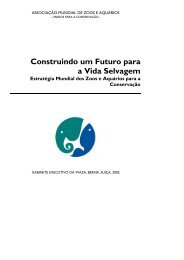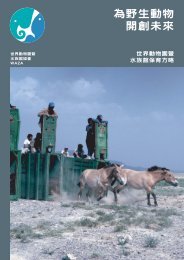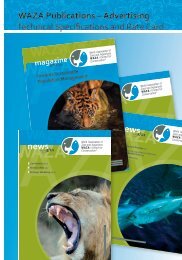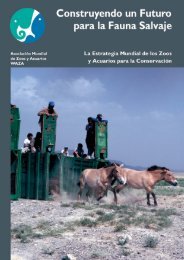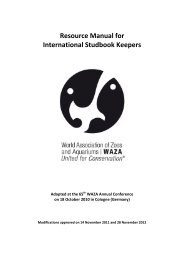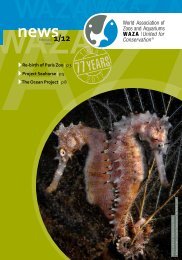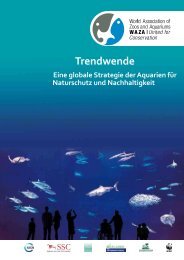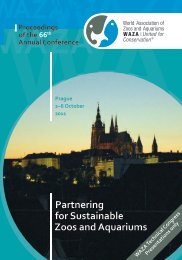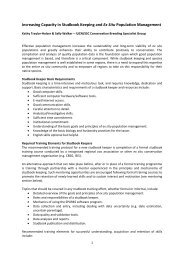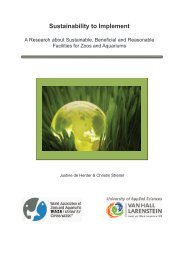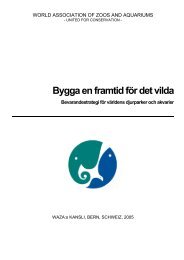Fighting Extinction - Waza
Fighting Extinction - Waza
Fighting Extinction - Waza
You also want an ePaper? Increase the reach of your titles
YUMPU automatically turns print PDFs into web optimized ePapers that Google loves.
38 Yarqon Bleak<br />
WAZA magazine Vol 13/2012<br />
»<br />
Following the success of the experimental<br />
pond and the government’s<br />
assurance regarding water, 12 sites<br />
along the Israeli coastal river system<br />
were assigned for reintroduction<br />
of the Yarqon bleak, most of them<br />
engineered to contain the species’ essential<br />
habitat. In 2006/2007 approximately<br />
9,000 laboratory-born fish<br />
were returned to nature. Offspring of<br />
fish originally captured in the Yarqon<br />
River were stocked in southern Israel,<br />
in or close to the Yarqon River basin,<br />
while offspring of fish originally captured<br />
in the Tut River were stocked<br />
in various rivers in the central and<br />
northern coastal system, in basins<br />
where this species had existed in the<br />
1950s. In surveys carried out from<br />
2007 onwards, fish of all sizes and<br />
ages, including juveniles, were found<br />
at most release sites. The various<br />
stages of the project are described in<br />
detail in Goren (2009).<br />
Outcome<br />
Our multiple-year effort to prevent<br />
the extinction of the Yarqon bleak<br />
clearly demonstrates that an imperilled<br />
fish species can be saved.<br />
The combination of experience and<br />
scientific research enabled us to keep<br />
the “refugee fish” alive, although<br />
initially they were sick and in very bad<br />
condition; to produce a large number<br />
of fish in the laboratory; to identify<br />
the reasons for the failure of the first<br />
reintroduced fish to breed; and to<br />
suggest effective solutions to these<br />
problems. The project can be regarded<br />
as highly successful (Goren 2010).<br />
The fish reproduced in nature over<br />
consecutive years and the population<br />
has increased significantly in size<br />
since the reintroduction. A permanent<br />
supply of good quality water to the<br />
rivers was promised by the government<br />
as part of a new approach called<br />
“The right of nature to water”. With<br />
breeding of released individuals and<br />
persistence over three generations as<br />
success indicators (Goren 2010), the<br />
Yarqon bleak, although still classified<br />
as Extinct in the Wild, has been successfully<br />
returned to nature.<br />
We learned two major lessons during<br />
this project: (1) There are no shortcuts<br />
in saving endangered species.<br />
These kinds of projects are long-term<br />
and consume a lot of time, money,<br />
goodwill and broad consensus of the<br />
neighbouring community. A devoted<br />
leader for such a project is the key to<br />
success. (2) The efforts to save an endangered<br />
species should be directed<br />
simultaneously to several channels:<br />
• Establishment of an efficient breeding<br />
facility for the fish and developing<br />
a professional maintenance<br />
protocol.<br />
• Research conducted by professional<br />
scientists on the relevant aspects of<br />
fish biology (diet, spawning habits,<br />
water quality and velocity, shelters,<br />
preferred temperatures for various<br />
stages of reproduction, preferred<br />
habitats, etc.).<br />
• Rehabilitation (water supply and<br />
quality) and engineering (spawning<br />
sites for adults and shelter for juveniles)<br />
of the habitat that is planned<br />
to accommodate the fish.<br />
• Experimental stocking of the fish in<br />
the rehabilitated habitat, followed<br />
by releasing the fish in sites that<br />
have been found to be suitable in<br />
the experimental stage.<br />
• Continued monitoring of the habitat<br />
and of the reintroduced fish population.<br />
• Public relations to raise awareness,<br />
achieve the funds needed for the<br />
project, secure a long-term supply<br />
of water in arid countries, and gain<br />
the support and goodwill of the<br />
public and decision-makers.<br />
Acknowledgements<br />
I am grateful to the students in my<br />
laboratory, especially E. Elron, B.<br />
Libes, Y. Krotman and Y. Gueta, for<br />
the endless time they spent on and<br />
their devotion to the project of saving<br />
the Yarqon bleak.<br />
References<br />
• Goren, M. (2004) Freshwater<br />
fishes in Israel. In: The Red Book:<br />
Vertebrates in Israel (ed. by Dolev,<br />
A. & Perevolotsky, A.), pp. 39–54.<br />
Jerusalem: Keter Printing.<br />
• Goren, M. (2009) Saving critically<br />
endangered fish species – utopia<br />
or practical idea? The story of the<br />
Yarqon bleak – Acanthobrama<br />
telavivensis (Cyprinidae) as a test<br />
case. Aqua, International Journal<br />
of Ichthyology 15: 1–12.<br />
• Goren, M. (2010) Re-introduction<br />
of the “Extinct in the Wild” Yarqon<br />
bleak, Israel. In: Global Reintroduction<br />
Perspectives: 2010<br />
(ed. by Soorae, P. S.), pp. 45–48.<br />
Abu Dhabi: IUCN/SSC Re-introduction<br />
Specialist Group.<br />
• Goren, M. & Ortal, R. (1999)<br />
Biogeography, diversity and conservation<br />
of the inland water fish<br />
communities in Israel. Biological<br />
Conservation 89: 1–9.<br />
• Goren, M., Fishelson, L. & Trewavas,<br />
E. (1973) The cyprinid fishes<br />
of Acanthobrama Heckel and<br />
related genera. Bulletin of the<br />
British Museum of Natural History<br />
(Zoology) 24: 291–315.



